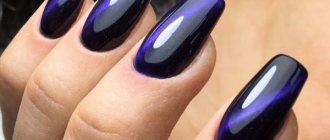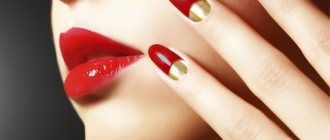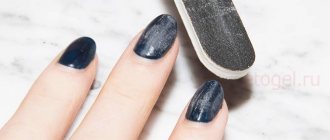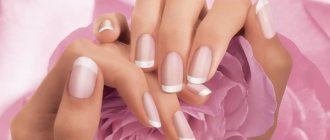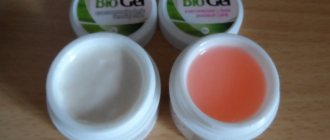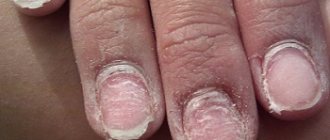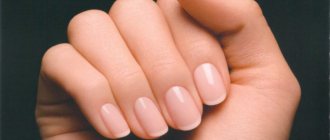Shellac is a gel nail polish that allows you to create a natural, neat, and most importantly durable manicure. It got its name thanks to the CND Shellac brand, which first introduced this type of varnish to the market. Today, many campaigns and varnish manufacturers include this term in their products.
Accordingly, a shellac manicure is a manicure performed using long-lasting gel polish that combines the best properties of regular polish and gel for nail extensions.
How to distinguish real shellac from fake?
The first and main sign of a fake is the low price. When purchasing any cosmetic product, cheapness is a sign of savings on product components. For example, cheap gel polishes have fewer components that help protect the nail. They are more harmful and also less durable.
Another indicator is smell. Almost all good cosmetics stores should have a sample next to each product. Which needs to be examined not only for color, but also for smell. Real shellac should not emit a sharp, unpleasant chemical aroma.
Next, using the same probe, you need to study the consistency of the drug. Its density should be medium: not too liquid, but not thick either. The first indicator will indicate that the gel polish was diluted with acetone (or any other similar product) to increase the volume of the batch. The second will indicate an expired expiration date or incorrect storage principle.
The most important thing when buying gel polish is to use only professional stores and purchase exclusively familiar brands.
Otherwise, you can allegedly save time and money, but not achieve the desired result (loss of money), or even ruin the appearance of the nail (wasting a lot of time on restoration).
Pros and cons of shellac compared to regular varnish
When creating shellac, the main goal was to create a nail coating that had durability (from gel) and color variety (varnish). To an inexperienced consumer, it may seem that gel polish and regular polish do not have significant differences: an identical application technique combined with the same appearance of the materials.
However, upon closer examination, the following differences can be deduced:
- Regular polish can dry in the fresh air, while gel polish requires exposure to a special lamp with ultraviolet rays. This technology has both positive and negative sides. The latter involves the need to purchase a specialized lamp, the price of which can reach up to 7 thousand rubles, and in some cases more. However, this equipment will eliminate long minutes of waiting and the fear of ruining the monolith of work done with simple hand movements.
- Shellac is somewhat limited in color palette than regular varnish.
- The cost of shellac is higher than the price of regular nail polish.
- The main difference between these coatings is the wear time: shellac stays on the nail without visible damage for up to 3 weeks.
- To remove nail polish, you just need to wipe the nail plate with nail polish remover. In the case of shellac, everything is not so simple: such a composition can only be removed using special mixtures.
Obviously, there should be differences between shellac and nail gel. Initially, the difference could be found in the presence or absence of color in the coating, but today gels with color are produced. Thus, there remains only one, but very significant difference - the purpose of applying these compositions to the nails.
The gel is intended for extension of the nail plate, which implies further manicure procedures. In this regard, the application techniques for shellac and gel are also different.
How does shellac affect nails?
The debate about the dangers of shellac for the nail plate has been going on for a long time: many complain that after removing the coating, their nails do not look their best. Of course, any impact on the nails can negatively affect their condition, causing deformation, layering and thinning. And the use of shellac is no exception.
However, by strictly following the technology of applying and removing the coating, you can avoid the consequences.
That’s why it’s so important to apply and remove shellac, for beginners, at home, step by step and following simple rules:
- Before performing the procedure, you should make sure that your own nails are healthy enough. It is not recommended to hide imperfections in the nail plate using the shellac procedure, since after removal the nails will acquire an even more deplorable condition.
- Before applying and after removing gel polish, your nails must be given proper assistance: apply moisturizing, nourishing and strengthening masks. The best results are obtained with products based on herbs (nettle, chamomile, aloe), glycerin and keratin.
- Brittle nails and increased splitting indicate a lack of calcium, which must be replenished with both external and internal means. Cosmetologists recommend starting to lubricate the nail plate with special medicinal varnishes containing calcium and other elements three weeks before the procedure. It is also worth taking a course of vitamin complexes, which must include calcium, vitamins D3 and B. They should be consumed during the entire period of wearing shellac and for a certain period of time after.
- After removing shellac, you must regularly use special nail baths. If the nail is severely split, it is recommended to undergo a wax sealing procedure.
Why do women increasingly prefer shellac coating?
Shellac is one of the most wearable coatings. Its durability has been tested more than once or twice in a variety of conditions. Shellac withstands endless women's troubles, while remaining in perfect condition. And changing the polish is only necessary because the nails are growing. What else attracts the fair sex in this coating?
- Applying and removing polish does not involve damaging the top layer of the nail plate, that is, the use of rough abrasive tools, especially for removing gel polish from nails, is excluded.
- To apply the coating, modern materials are used that do not harm the nails and do not cause allergies.
- Shellac protects nails from damage, allows them to strengthen, become stronger and healthier.
- Shellac is a long-lasting coating not only for fingernails, but also for toenails.
- Gel polish can be applied not only in a salon, but also at home.
- The opportunity to save your money and have impeccable hands, since one manicure set will last for a long time if you use the shellac technique at home.
- The opportunity to master the shellac technique to perfection and offer your services to friends and acquaintances, compensating for the costs of materials.
- The ability to look natural, since the coating eliminates the use of artificial nails.
- A wide range of colors - from delicate and shimmering shades to defiantly bright tones.
- The varnish is applied quickly, since all layers are fixed under a UV lamp, which means you can immediately get involved in active everyday activities without fear of ruining your manicure.
- The gel polish is removed using special liquids; this procedure does not take much time.
- After removing the coating, you can immediately apply a new one.
How often can shellac be applied?
You can often hear from manicurists that shellac can be applied an unlimited number of times. And this is not at all strange, because such procedures are their “bread”, a way to make a living.
But responsible professionals who are not trying to get rich at the expense of their clients argue that: although in the hands of experts who know what they are doing, shellac cannot cause much harm to the nails, it is still worth giving the nail plate a rest.
No matter how wonderful and harmless this product is, it still contains components that can deplete the nail , depriving it of essential microelements and vitamins. For example, to absorb calcium, nails need vitamin D, which is produced by the sun.
However, under the coating layer, the nails are unable to absorb the required dose of the vitamin.
Thus, the frequency of applying shellac has no clear restrictions. However, it is recommended that after each 3 procedure you give your nails a rest for at least 14 days, and in winter the period increases to 3 weeks.
Don't miss the most popular article in the section: How to draw monograms on nails step by step for beginners. Instructions with photos.
How long does it take on average to apply shellac?
If you have step-by-step instructions, any beginner can do a shellac manicure at home. However, for beginners this may take significantly longer than for professionals. Compared to applying conventional varnish, the shellac coating procedure has many nuances, new devices, tools and materials.
Therefore, it is very difficult to voice a specific part of the time: everything depends on the dexterity and adaptability to new conditions of the person who is going to perform the procedure. In addition, an important factor is the condition and quality of the nails themselves.
However, if we exclude the human factor and determine only the time of the procedures and the properties of the preparations (what to hold for how long, how long it will take to dry, etc.), then the whole process should not take more than 30-50 minutes.
Don't miss the most popular article in the section: How to extend nails with gel polish. Nail extension instructions for beginners. Photo.
Tools needed to apply shellac
Most of the tools needed for step-by-step application of shellac at home can also be found by beginners, as they are mandatory for every lady:
- manicure set (tongs, spatula, orange stick, files);
- brush for removing dust from the nail plate;
- ultraviolet lamp;
- lint-free wipes;
- foil with sponges.
Shellac application technique
If the coating application technology is strictly followed, it will delight you with its impeccable appearance for a long time. But in order to achieve the best result, you need to know some of the subtleties of manicure, which became known with the acquisition of experience, both from salon masters and at home. Let's look at the sequence of working with gel polish.
- Before applying shellac, a trim manicure is done. Many masters soften the cuticle with a special cream and move it to the base of the nail. Using a file, the nail is given the desired shape.
- Using a buff, light, gentle movements remove the shine from the nail plate. This is necessary for good adhesion of the materials to the surface of the nails. In places that are difficult to reach for the buff (on the sides of the nails and near the cuticle), the treatment is carried out with a finely abrasive file. The surface of the nail must not be filed down under any circumstances! It is lightly sanded until it acquires a matte tone.
- Use a cotton swab or small brush to carefully remove dust after treatment.
- Nail plates are degreased with special liquids.
- To avoid further peeling of the coating (especially for those whose nails do not hold artificial coatings well), you should apply a primer to your nails and dry it without a lamp for 1-2 minutes.
- A thin layer of base is applied to the nails. It is necessary to grasp the edge of the nail (sealing). The base is fixed (dried) under a UV lamp for 2 minutes. The nail must be sealed with a wrung out brush.
- Next, the first color layer is applied. It should be thin and cover all areas of the nail. With a pressed brush, grab the edge of the nail. The shellac is cured under a UV lamp for 2 minutes.
- A second layer of shellac is applied. The application technology repeats the application of the first layer.
- The finishing coat (top) is applied. Its thickness should be slightly thicker than the color layer. But you shouldn’t get carried away, otherwise divorces may appear. The top should lie flat, neatly and cover all areas of the nail, including their edges. The top is cured under a UV lamp for 2 minutes.
- The top sticky layer of the coating is removed using a special liquid.
- A caring oil is applied to the cuticle.
As can be seen from all of the above, there is nothing complicated when performing shellac technology. But there are some nuances, which we will talk about in the next section.
Preparing nails for shellac application
Not only the appearance of the manicure, but also the duration of its wear will depend on the correct preparation of the nail.
At this stage, you need to complete the following steps:
- Nutrition of the nail plate . Hands need to be steamed in a special bath, preferably based on medicinal herbs, for example, aloe. This is necessary to keep the nail in good condition.
- Cuticle removal . Steaming also helps to soften the cuticle, which means its better removal. You should also apply a special cuticle remover to the cuticle. Then move it to the edge of the nail using an “orange” stick and cut it off with pliers. It is worth noting that this “island” of skin must be trimmed as much as possible: the smaller the cuticle, the longer the regrowth of the plate will not be noticeable.
- Shaping. To a large extent, a successfully done manicure can be judged by the shape of the nail. It is worth remembering that after applying shellac it will not be possible to correct the shape. That is why it is necessary to give the nail the most attractive contours from the very beginning through the use of a nail file.
- Polishing . In order for the gel polish to lay evenly, without depressions and “incisors,” the nails must be “smoothed” using a special polishing file.
- Cleansing . Clean the nail from any nail powder remaining after the previous 2 steps. This must be done with a brush: the usual “blowing off” of dust will not be effective enough in this case.
- Removing fatty components . The completion of nail preparation is degreasing them with a special product. This is necessary for good bonding of the nail and shellac. After this procedure, you should not touch your nails with your hands or touch any other surfaces or objects with them.
Applying the base layer
This layer is designed to protect against the negative effects of the tinting layer, as well as improve its adhesion to the nail.
The application of each layer is divided into several points:
- Painting the left edge of the nail;
- Coloring the right edge;
- The final stroke in the center of the plate;
- Before performing the remaining steps, you need to make sure that the edges of the nail are thoroughly sealed with a coating.
This technique allows you to evenly distribute the coating over the surface of the nail without clinging to the skin.
The entire application process includes the following steps:
- The jar of varnish must be scrolled several times along the base of the palms. This will allow the shellac to warm up and settle evenly on the nail.
- Directly applying the foundation itself. The layer should not be thick, otherwise it will take longer to dry, which will lead to unwanted spots in the final result.
- Drying the coating. You need to dry it in a special lamp for about 13 seconds.
Applying shellac
This tonic layer gives the nails color and is applied according to the following instructions:
- Apply a thin layer of shellac. There is no need to seal the edges of the nail.
- Dry the coating in a lamp for about 3 minutes.
You can make shellac for beginners at home using step-by-step instructions from professionals. - Apply another coat of varnish. Moreover, you can use either the same color or a different one. By mixing two different shades you can get a very interesting and original option.
- Keep your nails under the lamp for another 3 minutes.
It is worth considering that the layers should be incredibly thin, almost transparent. Otherwise, the varnish may swell and form unpleasant bubbles.
Before applying the varnish, you need to check its condition: it should not be too thick. Damage to the coating can occur due to improper storage or purchasing a low-quality product, which will have a bad effect on the condition of the nails. It must be stored with the cap tightly screwed on and at room temperature. Also, do not leave it in areas exposed to sunlight.
The main mistakes when applying shellac
In order for a manicure with shellac to last longer on your nails, you must follow the instructions for applying it. By performing all the steps consistently, you will ensure a long-lasting and beautiful manicure for at least 3 weeks.
So, do not make the following mistakes when applying shellac:
- Don't forget to lubricate the cuticle with softening oil. This will help keep your manicure neat and tidy for a longer period.
- Do not mix varnishes from different companies. Nail coatings from different manufacturers differ in composition and structure. The stages of applying and removing shellac complement each other to create an even and durable finish. If you experiment with different manufacturers, the products may “come into conflict.” For example, the primer may not work, and then the coating will not adhere to the nail. The result is that the shellac will peel off within a few days.
- Do not remove your hands from the UV lamp before a special signal sounds. The timer is set to ensure that the coating dries to the required degree.
- Do not remove shellac yourself. Without knowing all the subtleties, you can damage your nail plate. If you are going to remove shellac at home, use a special remover.
- Do not tear off any peeling edges. If you see that the gel polish has peeled off somewhere, do not bite your nails or remove the shellac. You may damage the top layer of the nail plate. It is better to correct this nail at home.
By following the recommendations and instructions outlined in the article, you can achieve a beautiful and long-lasting manicure with shellac.
Share with your friends!
Subscribe to our Yandex.Zen channel or Yandex.Messenger
Applying decor
The scheme and technology for decorating nails with shellac is practically no different from decorating with regular varnish, however, here after decorating the nails you need to apply another layer of varnish.
Decor can be done using:
- Ribbons and strips;
- drawings;
- patterns;
- pictures;
- coloring technique, using multiple colors;
- sequins and rhinestones, etc.
Applying top coat
Finishing painting consists of only 3 steps:
- Direct application of the mixture, which has several nuances:
- it should be applied in a fairly thick layer;
- Using this coating, it is necessary to seal all the free edges of the nail (thus the colored base will remain, as it were, in an entomological vessel).
- Drying. The exposure time of hands under the lamp is no more than 130 seconds.
- Removing the sticky layer using a special product in which you need to moisten a lint-free cloth. It costs quite a lot, so in extreme cases you can use acetone or alcohol. However, these substances can slightly damage the manicure, so they should be used with caution.
What do you need to prepare?
For shellac manicure you will need:
- LED or UV lamp, ideally with a power of 36 watts, to speed up the drying of the nail coating;
- cuticle remover and cuticle softening oil;
- manicure set, including a coarse polisher and softer files;
- a degreaser created specifically for shellac, alcohol-based regular lint-free wipes;
- base gel and color shellac coating;
Beginners should not save money when purchasing manicure materials. Each item on this list will bring you closer to creating amazing nail designs on a professional level.
How to prepare your nails
Having collected all the paraphernalia necessary for a manicure, you can fully delve into the video tutorial on shellac manicure for beginners. After watching, every fashionista will undoubtedly be able to repeat step by step the entire technology for applying a stylish gel. It begins, as a rule, with preparatory procedures, special attention to which is paid in the first lessons.
Preparing nails for coating:
- After a standard herbal bath, the cuticle should be removed. If it is barely noticeable, there is no need to trim it. It is enough to soften it with oil and move it to the base of the nail with an orange stick.
- Using a file, you need to give your nails the desired shape, and then treat the nail plate step by step: first with a cotton pad to remove dust after sanding, then with a degreaser or an alcohol-based cloth. Experts recommend that beginners dry their nails under a UV lamp at this stage.
How to Apply Base Coat
So, the nail plate is ready for coating. Beginning craftsmen must now lay the coating on top step by step. The video shows you step by step how to paint with shellac. Photos of interesting manicure ideas are also offered to help guide the lessons for beginners. If beginners want to diversify their design, you can purchase special “color + rhinestones” sets or stencils to create luxurious French shellac.
Stages of work:
- Apply the base gel to the nails, drying for at least a minute under a UV lamp.
- Now you need to cover the base with colored gel, repeating the drying procedure. If the color intensity is insufficient, apply the color layer again.
- We fix the result with a thick layer of top base, use sparkles or rhinestones, not forgetting about lamp drying.
- All that remains is to eliminate the sticky layer using lint-free products and admire the results of the first lessons.
Little secrets
The authors who created video tutorials on shellac for beginners visually demonstrate the technique of performing a manicure. Still, it doesn’t hurt to get acquainted with the advice of experts on applying the gel.
Secrets of professionals:
- When applying the gel, use the “sealing” technology: first, one side edge of the nail is painted, then the other, and only then the gel is applied to the center of the nail plate. Beginners do not know that it is this technique that makes shellac long-lived. This is especially important when creating a French manicure.
- You only need to seal the first one - the base coat, but the colored one, on the contrary, is strictly forbidden - in this case it simply swells during lamp drying.
- You need to prepare not only your nails, but also the bottle of gel: roll it in your palms so that the pigment becomes even.
Shellac allows you to combine practicality and naturalness with elegance and beauty; shellac manicure lessons for beginners prove this step by step. Creating shellac at home, as the lessons show, is very simple. And the design will attract with its luxury and craftsmanship, even if it was created for the first time by a novice fashionista.
How to make French shellac yourself?
French shellac, for beginners at home, can be done step by step quite simply, the main thing is to follow the following technology:
- The initial stage is the nail preparation stage: removing the cuticle, shaping, polishing and removing sebum.
- Then you need to apply the primer and leave it for a while. When the nail has acquired a whitish tint, you can proceed to the next stage.
- Apply the base coat (left edge, right edge, middle, sealing the edges of the nail) in a small layer.
- Dry the plate under a specialized lamp for from a few seconds to 3 minutes, depending on the characteristics of the varnish.
- Using a special product and a napkin, remove the sticky layer formed after drying.
- Carefully attach the template without going over the top edge.
- Paint the upper part of the nail in the required color, and in as thin a layer as possible.
- Hold your nails near the lamp and remove the adhesive layer.
- Remove the template, being careful not to damage the applied varnish layer.
- Paint the plate with a final coat of shellac and let dry for a few seconds.
- Remove the adhesive layer.
How to make shellac (shilak) at home (instructions for beginners)
The process of covering nails with shellac is almost no different from the manicure procedure using regular varnish.
The main difference between this type of nail art is the use of a UV lamp, which must be used to dry each applied layer. Only with well-dried shellac will the manicure be even, smooth and durable.
Let's look at the shilak technique step by step. Step-by-step application at home will help you quickly master this practical type of manicure.
Applying the base
The most important procedure. Without a basic product, you won’t get a beautiful and even manicure. It is important that the base product is of excellent quality, then it will not harm the nail, but will strengthen it and protect it from the harmful effects of external factors. The base is applied in a thin layer twice, thoroughly drying each layer in a lamp for about 10 seconds.
Before application, twist the bottle, holding it with your palms, for half a minute. But shaking is not recommended due to possible damage to the structure of the gel polish. Cover the nail with shellac, making sure that it does not stain the skin (if it gets on, wipe it off with a smooth cloth).
Covering prepared nails
The initial layer should be almost transparent. After applying it, the nail is placed under a lamp, where it polymerizes for 2 minutes. After this time, a second layer is applied, thicker, and also dried under the lamp for the same amount of time.
Final action
Apply top coat, dry thoroughly under lamp for 2 minutes. An ordinary fixer will not work; it is the special coating that guarantees a stable and long-lasting result.
After all procedures, wipe the nails with a liquid to remove stickiness applied to a smooth napkin . You can also use alcohol, but you should check the shellac’s reaction to it in advance so that the alcohol does not “eat away” the mirror shine.
Interesting fact! To protect the skin of your hands from the negative effects of ultraviolet radiation, you need to apply sunscreen to your hands before the manicure procedure.
How to remove shellac correctly?
Instructions for removing shellac, for beginners at home, step by step are as follows:
- Divide the cotton wool and foil into portions for each nail.
- Wash your hands and nails thoroughly with detergent.
- Soak one piece of cotton wool with shellac remover.
- Apply to the nail so that the product does not come into contact with the skin. This mixture contains some components that, when exposed to the epidermis for a long time, can damage it.
- Carefully wrap with foil so that the fleece does not slip.
- Do steps 3-5 with each finger.
- The exposure time is approximately 13 minutes, during which the foil on the nail needs to be slightly “tugged”.
- After the time has passed, first remove the foil and then the cotton wool from each finger individually.
- Remove the soaked layers of manicure with your hands or (if you can’t remove them) with an “orange” stick.
- Finally, rinse your hands with soap.
How to properly remove gel polish (shellac)
Since this type of varnish is different from the usual one, the removal procedure is a little more complicated than usual.
It is necessary to carefully file the surface of the shellac with a nail file. After this, wrap each nail with cotton pads and nail polish remover, and wrap the top with foil. After 10 minutes, everything is removed along with the shellac. If there are any painted areas, carefully scrape off the gel polish with a stick.
Create conditions using foil to make shellac removal easier
The procedure for creating nail art using shilak at home is complicated only at first glance. Strict step-by-step application, observing all the subtleties, guarantees a fashionable and durable manicure without harm to the health of the nails.
How to properly apply shellac at home? Watch this helpful video:
Step-by-step technology for applying shellac yourself at home. Watch video instructions:
How to properly remove and apply shellac at home? Find out from the video:
Nail care after shellac removal
To restore nails and protect them from further damage, it is necessary to carry out cosmetic procedures.
These include:
- Olive oil bath . Heat a small amount of it in water. Keep your fingers in the bath for about 13 minutes, every day for 3 weeks.
- Lemon juice mask. Place a drop of fresh citrus juice on each nail and then rub in with gentle movements. Leave for about 3 minutes, then rinse with running water.
- Sour berry mask . Mash any sour berry (for example, viburnum or lingonberry) into a paste. Apply to the plate and, wrapping it in foil, leave for 13 minutes.
- No less than nails, cuticles will also need care. They must be soaked daily with any essential oil . There is no need to rinse it off, so the amount of oil should be minimal.
If the nails are excessively weakened and peeling, more complex cosmetic procedures should be performed:
- Sealing a nail with wax in a salon. With its help, the nails, covered with a thin film, will be protected from further damage and will also acquire a healthier appearance.
- You can buy a special medicinal varnish at any pharmacy. The base of such a varnish must include calcium, many vitamins, and keratin. With regular use, the polish will heal your nails, making them stronger. And from the very first use, making the nails thicker due to the coating, the varnish will relieve discomfort and the fear of breaking the nail.
Applying shellac at home is quite simple even for beginners, especially if you use step-by-step instructions. However, so that the beautiful appearance of your nails does not become a fleeting pleasure, the plates must be looked after both before and after the procedure.
What do you need for shellac?
Is it possible for pregnant women to do shellac?
You can do a beautiful manicure with gel polish yourself if you study the basic points.
Shellac Tools
List of tools you will need to apply shellac at home:
- File. Nails must be treated before coating. You can give the desired shape and length with a glass or metal file;
- Buff. A special volume file that removes gloss from the nail plate. They differ in hardness and grain size;
- Brush. Use a brush with hard bristles to clean the nail from dust after filing;
- Metal pusher or orange stick. Using these tools, you need to carefully push the cuticle to the base of the nail. Orange sticks are convenient for decorating nails (making a drawing, design or gluing rhinestones, stickers);
- Nail clippers. Excess cuticle is trimmed with sharp tweezers;
- Cuticle remover. If you have no experience how to use nippers, then it is better to use a special cuticle remover;
- Shellac lamp. Lamps are needed for the shellac to harden. They are: LED, fluorescent, ultraviolet. Most often, salons use UV lamps;
- Primer (degreaser). The product is applied to the nails to dry and degrease. If there is no primer, you can use medical alcohol. But without a primer, there is a possibility that the shellac will quickly peel off;
- Base. A colorless gel that is applied after the degreaser;
- Shellac and finishing gel. Shellac comes in different shades. It is applied in 2 layers. The last layer is the finishing gel, which gives the nails shine and fixes the shellac;
- Cuticle oil. Softens the skin around the nail;
- Cream. Finally, a softening cream is applied to the hands.
